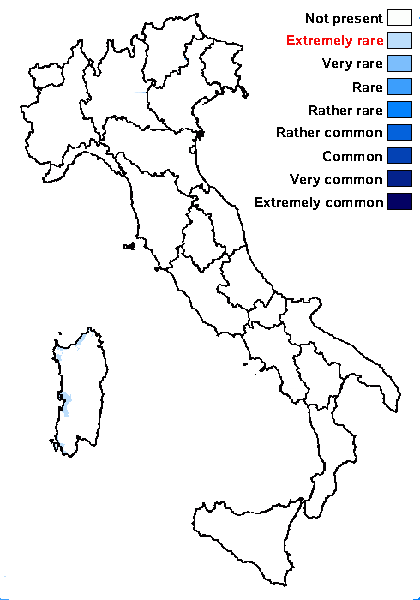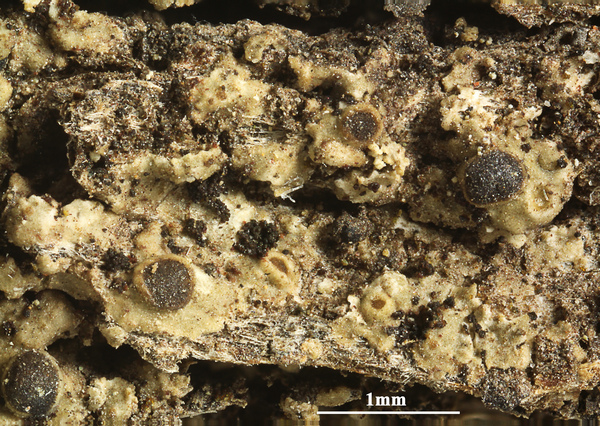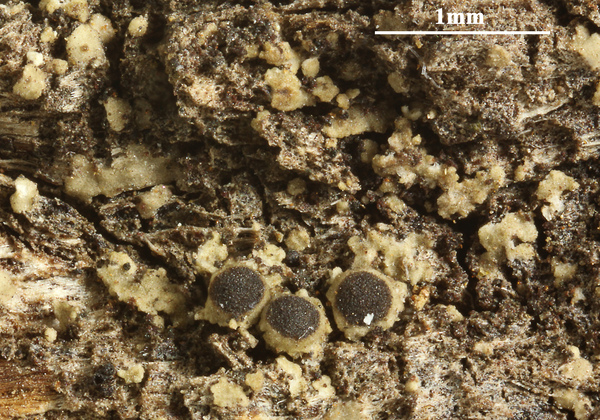Rinodina colobinoides (Nyl.) Zahlbr.
Cat. Lich. Univ., 7: 499, 1931. Basionym: Lecanora colobinoides Nyl. - Acta Soc. Sc. Fenn., 7: 444, 1863.
Synonyms: Lecanora erysiphaea Nyl.; Rinodina erysiphaea (Nyl.) Zahlbr.; Rinodina sorediata H. Magn.
Distribution: C - Sar.
Description: Thallus crustose, episubstratic, at first composed of dark grey, 0.4-1.5 mm wide areoles, later almost entirely covered with pale green to olivaceous, (20-)35-60(-100) μm wide blastidia. Apothecia lecanorine, scattered, (0.3-)0.7-1(-1.3) mm across, with a flat to strongly convex, dark brown to black disc, and a thick, prominent, entire to crenulate, often blastidiate, finally sometimes excluded thalline margin; proper margin only sometimes visible as a brownish-yellow excipular ring within the thalline margin. Thalline exciple 60-100 μm wide laterally, indistinctly corticate, the cortical cells thin-walled, 4-6 μm in diam.; proper exciple 10-15 μm wide laterally, expanding to 30-35 μm in upper part; epithecium yellowish brown to olivaceous brown, K-; hymenium colourless, 65-80(-110) μm high; paraphyses up to 2.5 μm thick at mid-level, the apical cells 4-7(-8) μm wide; hypothecium colourless to yellowish, 60-70 μm high. Asci 8-spored, clavate, the K/I+ blue tholus penetrated by a faintly amyloid apical cushion with parallel or diverging flanks, the wall K/I-, surrounded by a K/I+ blue outer layer, Lecanora-type. Ascospores 1-septate, brown, ellipsoid, 14-19(-21) x 6.5-8.5(-10) μm, Pachysporaria-type, some of them tending towards the Physcia-type, smooth-walled, with a well-developed torus, the ontogeny of type A (apical wall thickening after the early septum formation). Photobiont chlorococcoid. Chemistry: thallus K-, C-, KC-, P-; large parts of medulla and apothecial tissues with a yellowish-orange pigment reacting K+ pink. Chemistry: apart from the unknown pigment, thallus without lichen substances. Note: an oceanic species with a wide, tropical to subtropical distribution, found base-rich bark; known from Sardinia, to be looked for further in Tyrrhenian Italy.
Growth form: Crustose
Substrata: bark
Photobiont: green algae other than Trentepohlia
Reproductive strategy: mainly asexual, by soredia, or soredia-like structures (e.g. blastidia)
Restricted to humid-warm, oceanic areas
Commonnes-rarity: (info)
Alpine belt: absent
Subalpine belt: absent
Oromediterranean belt: absent
Montane belt: absent
Submediterranean belt: absent
Padanian area: absent
Humid submediterranean belt: absent
Humid mediterranean belt: extremely rare
Dry mediterranean belt: absent

Predictive model


Felix Schumm CC BY-SA 4.0
[19711], Venezuela, Lara, District Torres, ca. 35 km E of Barquisimeto, in a light and dry half steppe, on the bark of an unidentified tree, 650 m, 10°10' N, 69°50' W. Leg. K. & A. Kalb, 20.8.1989, det. A. Aptroot. KALB: LICHENES NEOTROPICI NR. 646.

Felix Schumm - CC BY-SA 4.0
[19711], Venezuela, Lara, District Torres, ca. 35 km E of Barquisimeto, in a light and dry half steppe, on the bark of an unidentified tree, 650 m, 10°10' N, 69°50' W. Leg. K. & A. Kalb, 20.8.1989, det. A. Aptroot. KALB: LICHENES NEOTROPICI NR. 646.
Growth form: Crustose
Substrata: bark
Photobiont: green algae other than Trentepohlia
Reproductive strategy: mainly asexual, by soredia, or soredia-like structures (e.g. blastidia)
Restricted to humid-warm, oceanic areas
Commonnes-rarity: (info)
Alpine belt: absent
Subalpine belt: absent
Oromediterranean belt: absent
Montane belt: absent
Submediterranean belt: absent
Padanian area: absent
Humid submediterranean belt: absent
Humid mediterranean belt: extremely rare
Dry mediterranean belt: absent

Predictive model


Felix Schumm CC BY-SA 4.0
[19711], Venezuela, Lara, District Torres, ca. 35 km E of Barquisimeto, in a light and dry half steppe, on the bark of an unidentified tree, 650 m, 10°10' N, 69°50' W. Leg. K. & A. Kalb, 20.8.1989, det. A. Aptroot. KALB: LICHENES NEOTROPICI NR. 646.

 Index Fungorum
Index Fungorum
 GBIF
GBIF



